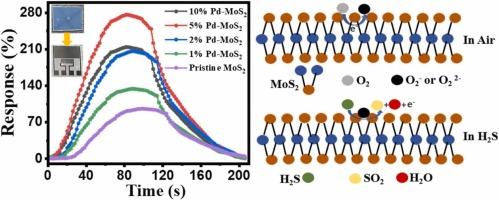APCVD合成pd掺杂MoS2的超灵敏选择性室温H2S检测
IF 3.7
1区 化学
Q1 CHEMISTRY, ANALYTICAL
引用次数: 0
摘要
微量有害硫化氢(H2S)气体的检测对环境监测和工业安全至关重要。在本研究中,利用常压化学气相沉积(APCVD)在SiO2/Si衬底上合成了不同Pd浓度(1、2、5和10 at%)的原始和掺杂钯(Pd)的二硫化钼(MoS2)薄膜。在动态流动气敏装置中,分析了室温下气敏性能。在100 ppm H2S条件下,5 at% pd掺杂的MoS2传感器的响应率为276%,明显优于原始MoS2的96%。该传感器的响应时间和恢复时间分别为45秒和65.8秒。检测限(LoD)为0.3 ppb,定量限(LoQ)为0.99 ppb,表明具有超灵敏的检测能力。此外,密度泛函理论(DFT)研究为实验结果提供了理论验证,证实了Pd掺杂改变了MoS2的电子性质,增强了其与H2S气体分子的相互作用。综合表征技术,包括x射线衍射(XRD),拉曼光谱,I-V特性和x射线光电子能谱(XPS)证实了成功合成并掺杂了Pd的MoS2。这项实验和计算相结合的研究为Pd掺杂对MoS2的影响提供了有价值的见解,从而通过本研究获得了5 at% Pd掺杂的MoS2优越的气敏性能。在% pd掺杂下生长的MoS2传感器具有优异的重复性、长期稳定性和选择性,使其成为痕量水平下实时、高灵敏度H2S检测的有希望的候选者本文章由计算机程序翻译,如有差异,请以英文原文为准。

Ultrasensitive and selective room temperature H2S detection using Pd-doped MoS2 synthesized via APCVD
The detection of trace amounts of hazardous hydrogen sulfide (H2S) gas is crucial for environmental monitoring and industrial safety. In this study, pristine and palladium (Pd)-doped molybdenum disulfide (MoS2) thin films with varying Pd concentrations (1, 2, 5, and 10 at%) were synthesized on SiO2/Si substrates using atmospheric pressure chemical vapor deposition (APCVD). Gas sensing performance was analyzed at room temperature (RT) in a dynamic flow gas sensing setup. The 5 at% Pd-doped MoS2 sensor exhibited the best response of 276 % at 100 ppm H2S, significantly outperforming pristine MoS2, which showed a response of 96 %. The sensor also exhibited rapid response and recovery times of 45 and 65.8 s, respectively. A limit of detection (LoD) of 0.3 ppb and a limit of quantification (LoQ) of 0.99 ppb were achieved, indicating ultrasensitive detection capabilities. Additionally, density functional theory (DFT) studies were conducted to provide theoretical validation of the experimental results, to confirm that the Pd doping changes the electronic properties of MoS2 and enhances its interaction with H2S gas molecules. Comprehensive characterization techniques, including X-ray diffraction (XRD), Raman spectroscopy, I-V characteristics, and X-ray photoelectron spectroscopy (XPS) confirmed the successful synthesis and doping of MoS2 with Pd. This combined experimental and computational study provides valuable insights into the effects of Pd doping on MoS2 resulting in the superior gas sensing performance of the 5 at% Pd-doped MoS2 through the present investigations. As grown 5 at% Pd-doped MoS2 sensor was characterized by excellent reproducibility, long-term stability and selectivity, making it a promising candidate for real- time, highly sensitive H2S detection at trace levels
求助全文
通过发布文献求助,成功后即可免费获取论文全文。
去求助
来源期刊

Sensors and Actuators B: Chemical
工程技术-电化学
CiteScore
14.60
自引率
11.90%
发文量
1776
审稿时长
3.2 months
期刊介绍:
Sensors & Actuators, B: Chemical is an international journal focused on the research and development of chemical transducers. It covers chemical sensors and biosensors, chemical actuators, and analytical microsystems. The journal is interdisciplinary, aiming to publish original works showcasing substantial advancements beyond the current state of the art in these fields, with practical applicability to solving meaningful analytical problems. Review articles are accepted by invitation from an Editor of the journal.
 求助内容:
求助内容: 应助结果提醒方式:
应助结果提醒方式:


